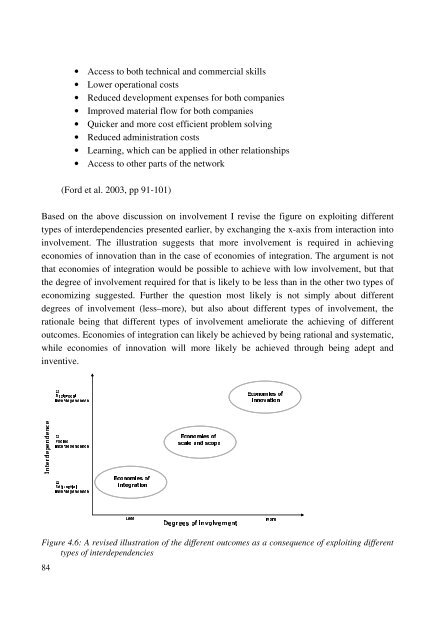Value Co-Creation in Industrial Buyer-Seller Partnerships ... - Doria
Value Co-Creation in Industrial Buyer-Seller Partnerships ... - Doria
Value Co-Creation in Industrial Buyer-Seller Partnerships ... - Doria
- No tags were found...
Create successful ePaper yourself
Turn your PDF publications into a flip-book with our unique Google optimized e-Paper software.
ÁÅ¿ÁÅ¿¿Á¿Á‘ ‘ž ž• Access to both technical and commercial skills• Lower operational costs• Reduced development expenses for both companies• Improved material flow for both companies• Quicker and more cost efficient problem solv<strong>in</strong>g• Reduced adm<strong>in</strong>istration costs• Learn<strong>in</strong>g, which can be applied <strong>in</strong> other relationships• Access to other parts of the network(Ford et al. 2003, pp 91-101)Based on the above discussion on <strong>in</strong>volvement I revise the figure on exploit<strong>in</strong>g differenttypes of <strong>in</strong>terdependencies presented earlier, by exchang<strong>in</strong>g the x-axis from <strong>in</strong>teraction <strong>in</strong>to<strong>in</strong>volvement. The illustration suggests that more <strong>in</strong>volvement is required <strong>in</strong> achiev<strong>in</strong>geconomies of <strong>in</strong>novation than <strong>in</strong> the case of economies of <strong>in</strong>tegration. The argument is notthat economies of <strong>in</strong>tegration would be possible to achieve with low <strong>in</strong>volvement, but thatthe degree of <strong>in</strong>volvement required for that is likely to be less than <strong>in</strong> the other two types ofeconomiz<strong>in</strong>g suggested. Further the question most likely is not simply about differentdegrees of <strong>in</strong>volvement (less–more), but also about different types of <strong>in</strong>volvement, therationale be<strong>in</strong>g that different types of <strong>in</strong>volvement ameliorate the achiev<strong>in</strong>g of differentoutcomes. Economies of <strong>in</strong>tegration can likely be achieved by be<strong>in</strong>g rational and systematic,while economies of <strong>in</strong>novation will more likely be achieved through be<strong>in</strong>g adept and<strong>in</strong>ventive.²©³@´µd´ · ¸©¹´©º’X“T”Z• –X— Õ”^Xš• ›fœ “X— X“X–T“X›TO“M›Z”^“ •· µoµd´©»¼©½O· ´µ ·²d³´µd´'· ¸©¹´©ºÁ à Á ß^Õ˜Mš“T¹@³¼tÆ ¸¼tµ©Ç'¹@³´Èd¸• ›fœ “X— X“X–T“X›TO“M›Z”^“ •ÁÄ Ã ÁÄ ÃÀÁ¿ ¾ ¿ ¾²©³@´µ©´'· ¸©¹´©º¡ “T¢@£Z“M›fœ •Mš ¡Ê · µ½f¸©É Ê ¼©½O· ´µ ·• ›fœ “X— X“X–T“X›TO“M›Z”^“ •Í “Ë “TÌ^Ì Í ˜M— “ˬ ±¤¥ ¦§O¥w¥¦¨¡© ª« ¬ j©*® w¥*¯°¥j¬ ±Figure 4.6: A revised illustration of the different outcomes as a consequence of exploit<strong>in</strong>g differenttypes of <strong>in</strong>terdependencies84
















